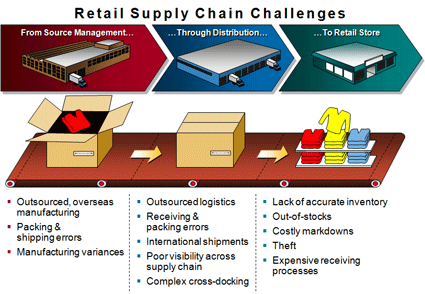Retail Supply Chain
Challenges
Consider the challenges retailers face in managing their inventory:
- Outsourced manufacturing operations thousands of miles away make it difficult to know what is happening and even more difficult to manage.
- Outsourced distribution operations create another level of complexity, adding to the unknowns of the retailer’s operations.
- In-store operations are inherently challenging, with the constant need to try to match inventory to shoppers’ needs.

These challenges are magnified in adverse economic conditions.
“Macy's flagship store has racks of summer tops, swimwear and dresses marked down as much as 50 percent, while luxury retailer Bergdorf Goodman is slashing prices on designer goods by as much as 70 percent.” - Summer
spenders get cold feet,
|
“Worried about getting stuck with products that recession-wracked shoppers won’t buy, some chains have cut stocks by as much as 20% compared to prior years’ levels… Retailers said they would rather run the risk of running out of merchandise than suffer mark downs to move excess goods. The last thing they want is a repeat of last Christmas, when a sudden fall-off in consumer spending left them with mountains of merchandise they were forced to discount, leading to sharp drops in profits.” - Stores Anxiously Watch Back-to-School
Sales, |
With shoppers cutting back, retailers have only one
chance to make the sale. They must have the merchandise
that customers want when they come in. But if they
hold too much inventory, they risk overstocks and
costly markdowns, which present an even greater problem
when credit markets are tight and the cost of capital
needed to fund inventory is high. Inventory management
is critical to retailers’ profitability.
Yet the evidence shows that retailers’ ability
to manage their inventory to meet dynamic market
conditions largely fall short:
- Global out-of-stocks are 8.3% (Global GMA Study, 2007). From a shopper’s perspective, this means that for every 13 items one wants to buy, one will be out of stock (Corsten and Gruen, 2007)
- 65% inventory inaccuracy (Harvard Business School study)
- Retailers on average lose 4% of their annual sales due to out-of-stock items (Corsten and Gruen, 2007)
- 22% of out-of-stocks are caused by shelf replenishment issues in the store, when the item is in the store but not on the shelf (Corsten and Gruen, 2003)
In-store operations pose a particular challenge for retailers, due to increasing product variety and SKU proliferation coupled with decreasing space for inventory. In the 1970s, backroom storage accounted for about 30 percent of a store's square footage, but that amount has dwindled to 15 percent or less today, according to industry figures. (Grocery Headquarters Magazine, 2008)
OAT
SOLUTIONS SUPPORT: Barcode - Passive RFID - Active RFID - Ultra Wide Band RF (UWB) - Wi-Fi - RTLS - RFID-enhanced EAS - Location Servers - GPS - Application Sensors (e.g. Stack Lights, PLCs, alarms...) |
||







 OAT Foundation Suite
OAT Foundation Suite







